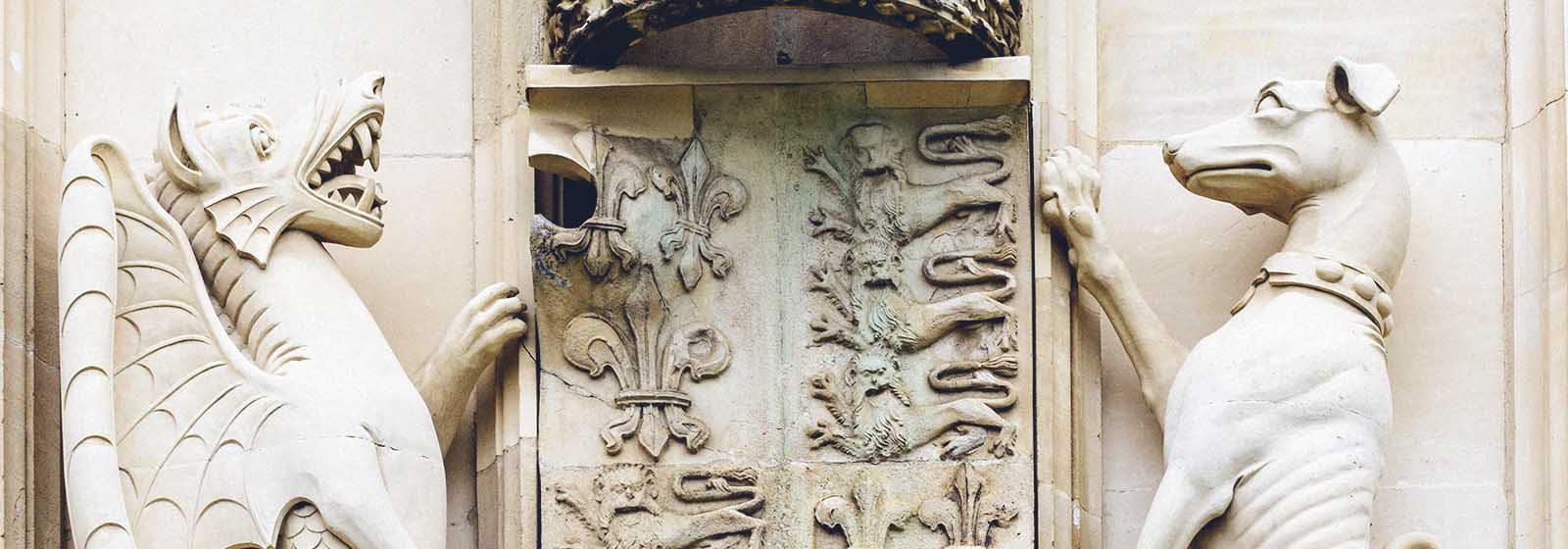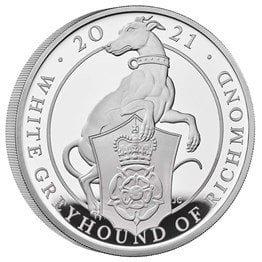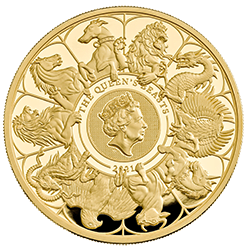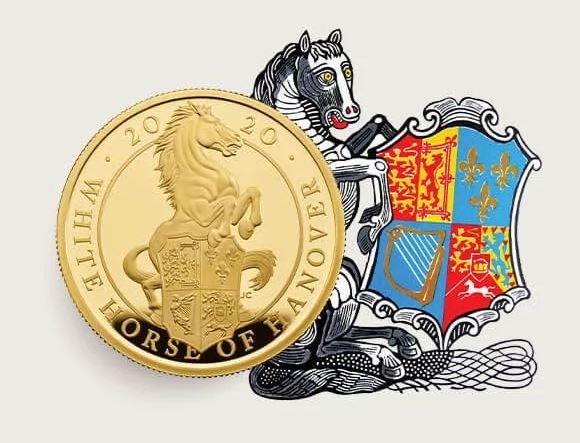The White Greyhound of Richmond
The White Greyhound of Richmond coin
The White Greyhound of Richmond is the ninth coin in this popular British coin collection featuring The Queen’s Beasts.
 |
|---|
The White Greyhound of Richmond Brilliant Uncirculated Coin
Buy Brilliant Uncirculated Coin
- A great gift to inspire an interest in British history
- The ninth coin in this popular British collection
- Acclaimed designer Jody Clark has designed sides of the coin
- Finished to Brilliant Uncirculated standard – superior to the quality of the coins found in your change
- Explore the history of the white greyhound in the coin’s bright fold-out packaging
| DENOMINATION | £5 |
|---|---|
| ALLOY | Cupro-nickel |
| WEIGHT | 28.28 g |
| DIAMETER | 38.61mm |
| REVERSE DESIGNER | Jody Clark |
The White Greyhound of Richmond coins for sale
Choose from BUNC, Silver Proof and Gold Proof limited edition presentations. Click the “Buy It Now” button to secure your coin whilst stocks last! Your coins will be delivered direct from The Royal Mint.
Prices are correct at the time of posting, subject to change at any time. Add P&P.
You will be ordering the coins directly from The Royal Mint online coin shop.
The Queen’s Beasts Coin Collection
The Queen’s Beasts Coin Collection nears conclusion with the penultimate release in this ten-coin series.
The White Greyhound of Richmond is one of the ten ancestral beasts that lined the entrance to Westminster Abbey at Her Majesty The Queen’s coronation. The coins are available in Gold and Silver precious metal Proof editions, as well as a Brilliant Uncirculated edition.
The greyhound was first used as a royal beast by Edward III and is a symbol of fitness, speed, and skill coupled with loyalty. Strongly associated with the House of Lancaster, it later became a symbol of the Tudor family when it was bestowed on Edmund Tudor by his half-brother Henry VI. After slaying Richard III at the Battle of Bosworth in 1485, Edmund’s son was crowned Henry VII. He used the white greyhound to display his Tudor and Lancastrian ancestry, denoting his right to rule.
The Story of The White Greyhound of Richmond
The White Greyhound of Richmond has a long and storied history, linking our present queen to her ancestor Henry VII, founder of the Tudor dynasty. As this powerful and elegant creature takes its place amongst The Queen’s Beasts, we examine the story behind its symbolism and discover its origins as a royal beast.
A Loyal Companion
Exceptionally fast, intelligent, and blessed with keen eyesight, greyhounds were bred for hunting and coursing game. As one of the world’s oldest breeds, dogs of this kind were present in Britain during the Roman occupation; they are also known to have been included in royal hunting packs as early as the twelfth century.
Hunting had a special prestige in the royal courts of the Middle Ages therefore the greyhound came to be considered a prestigious creature, carrying connotations of physical fitness and skill. It became associated with wealth and leisure, as well as the chivalric virtues of faithfulness and loyalty, and the elegance and nobility of the breed enhanced this prestige.
As a result, the greyhound was widely used in heraldry as well as in the decorative arts.

A Royal Beast
The greyhound first appears as a royal beast during the reign of Edward III. He used a wide variety of heraldic badges, but the greyhound gained prominence amongst them when it appeared on his Great Seal – known as the Bretigny Seal – in 1360. The obverse of this seal has an image of the king flanked by two small shields of the Royal Arms, each with a greyhound standing beneath it. This design of the Great Seal was used as a model for those of the subsequent kings, Richard II, Henry IV, Henry V, and Henry VI, until Edward IV replaced the greyhounds with bulls.
Heir Apparent
The sons and descendants of Edward III all used the greyhound as a heraldic beast at different times – mostly a white greyhound, with a red collar. Amongst these descendants, the device became most intimately associated with the House of Lancaster, beginning with John of Gaunt. The greyhound was used as a beast by his son Sir John Beaufort; John of Gaunt’s grandson Henry V also used the beast and had an Officer of Arms named Blanc Levrier (white greyhound).
The Earldom of Richmond
The greyhound had a more particular significance for the Tudors. Tudor heralds were clear that the greyhound stood for the earldom of Richmond. This great noble title derived from the Honour of Richmond, a significant collection of manors in Yorkshire. From the Norman Conquest until 1341, the Honour was held by members of the ducal house of Brittany. The title and lands were then held by John of Gaunt, the immensely rich and powerful Duke of Lancaster who was the third son of Edward III; they finally passed back to the Crown and were then granted to Edmund Tudor, father of Henry VII, in 1449.
Kinship to the King
In 1449, Henry VI granted the earldom of Richmond, together with its associated vast estates in Yorkshire, to his half-brother and closest kinsman Edmund Tudor, son of his mother Catherine of Valois. With this grant, Edmund received Henry’s permission to use a particular version of the Royal Arms, despite not being of the Plantagenet line, together with supporters to the Arms of a white greyhound wearing a red collar, along with a Welsh red dragon. The greyhound was intended as a reference to his close kinship to the king, whose beast it was.
The Right to Rule
The use of the device by Edmund Tudor, combined with his status as Earl of Richmond, meant that for Tudor heralds fifty years later, the greyhound and the title were inseparable: for the Tudors, the greyhound stood for the earldom and Honour of Richmond. Edmund Tudor’s only son would come to the throne as Henry VII in 1485 following the defeat of Richard III at the Battle of Bosworth. The greyhound expressed both his Tudor and Lancastrian ancestry, through which he claimed the throne, and from then on the greyhound of Richmond would be an accepted royal beast.
The Greyhound in Heraldry
The greyhound came to be the Tudor family’s special beast. In the sixteenth-century chapel of King’s College, Cambridge, where the Royal Arms are depicted supported by different beasts to indicate their different families, a greyhound was chosen to represent the Tudors. Henry VII certainly used the greyhound very widely and it invariably appears with a dragon as one of the supporters to his Arms; it was also used in this way by his son Henry VIII. Both kings used Standards with greyhounds as the principle device and the ‘Standard of the Greyhound’ was carried in Tudor royal funerals. Prestigious royal building projects, such as St George’s Chapel for the Order of the Garter at Windsor, were decorated with carved white greyhounds collared in red.




